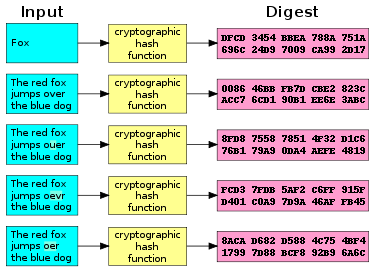This article needs additional citations for verification. (May 2016) |

| Secure Hash Algorithms | |
|---|---|
| Concepts | |
| hash functions, SHA, DSA | |
| Main standards | |
| SHA-0, SHA-1, SHA-2, SHA-3 | |
A cryptographic hash function (CHF) is a hash algorithm (a map of an arbitrary binary string to a binary string with a fixed size of bits) that has special properties desirable for a cryptographic application:[1]
- the probability of a particular -bit output result (hash value) for a random input string ("message") is (as for any good hash), so the hash value can be used as a representative of the message;
- finding an input string that matches a given hash value (a pre-image) is infeasible, assuming all input strings are equally likely. The resistance to such search is quantified as security strength: a cryptographic hash with bits of hash value is expected to have a preimage resistance strength of bits, unless the space of possible input values is significantly smaller than (a practical example can be found in § Attacks on hashed passwords);
- a second preimage resistance strength, with the same expectations, refers to a similar problem of finding a second message that matches the given hash value when one message is already known;
- finding any pair of different messages that yield the same hash value (a collision) is also infeasible: a cryptographic hash is expected to have a collision resistance strength of bits (lower due to the birthday paradox).
Cryptographic hash functions have many information-security applications, notably in digital signatures, message authentication codes (MACs), and other forms of authentication. They can also be used as ordinary hash functions, to index data in hash tables, for fingerprinting, to detect duplicate data or uniquely identify files, and as checksums to detect accidental data corruption. Indeed, in information-security contexts, cryptographic hash values are sometimes called (digital) fingerprints, checksums, or just hash values, even though all these terms stand for more general functions with rather different properties and purposes.[2]
Non-cryptographic hash functions are used in hash tables and to detect accidental errors; their constructions frequently provide no resistance to a deliberate attack. For example, a denial-of-service attack on hash tables is possible if the collisions are easy to find, as in the case of linear cyclic redundancy check (CRC) functions.[3]
- ^ Menezes, van Oorschot & Vanstone 2018, p. 33.
- ^ Schneier, Bruce. "Cryptanalysis of MD5 and SHA: Time for a New Standard". Computerworld. Archived from the original on 2016-03-16. Retrieved 2016-04-20.
Much more than encryption algorithms, one-way hash functions are the workhorses of modern cryptography.
- ^ Aumasson 2017, p. 106.



